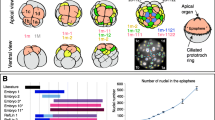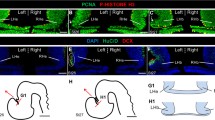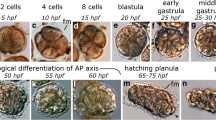Summary
In the evolution of land-living vertebrates, the transition from spending the entire life cycle in the water to first a biphasic (adult on land, eggs and larvae in water) and later a terrestrial life-history mode was achieved by changes in developmental processes and regulatory mechanisms. Lungfishes, salamanders and frogs are studied as examples of species which span this transition. The migration and fate of the embryonic cells that form the head is studied, using experimental embryology (extirpation and transplantation of cells), molecular markers and novel microscopy techniques — such as confocal microscopy. Knowing the migratory routes and fates of the cells that form head structures is important for an elucidation of the changes that took place e.g. when gill arches transformed into head cartilages, and when the specialised larval mouth structures present in today’s frogs and toads arose as an evolutionary innovation. Results so far indicate that the early migration and pattern formation of neural crest cells in the head region is surprisingly conserved. Both the amphibians investigated and the Australian lungfish have the same number of migrating neural crest streams, and the identity of the streams is preserved. The major difference lies in the timing of migration, where there has been a heterochronic shift such that cell migration starts much later in the Australian lungfish than in the amphibians. The molecular mechanisms regulating the formation of streams of cranial neural crest cells seem, at least in part, to be differential expression of ephrins and ephrin receptors, which mediate cell sorting. Our understanding of the behaviour of migrating cells (primarily the more well characterised neural crest cells) could be enhanced by a modelling approach. I present preliminary ideas on how this could be achieved, inspired by recent work on Dictyostelium development and our own previous work on pigment cells and their pattern formation during salamander embryogenesis.
Similar content being viewed by others
References
Bolker, J. A. (1995) Model systems in developmental biology. BioEssays 17: 451–455.
Cannatella, D. C. (1999) Architecture: cranial and axial musculoskeleton. In: McDiarmid RW, Altig R, (eds) Tadpoles: The Biology of Anuran Larvae. Chicago: University of Chicago Press. pp 52–91.
Clack, J. A. (2000) The origin of tetrapods. In: Heatwole H, Carroll RL, (eds). Amphibian Biology. Chipping Norton: Surrey Bearry & Sons. pp 979–1029.
Couly, G. F., Coltey, P. M., Le Douarin, N. M. (1992) The developmental fate of the cephalic mesoderm in quail-chick chimeras. Development 114: 1–15.
Epperlein, H. H., Löfberg, J. (1990) The development of the larval pigment patterns in Triturus alpestris and Ambystoma mexicanum. Adv. Anat. Embryol. Cell Biol. 118: 1–101.
Epperlein, H. H., Löfberg, J., Olsson, L. (1996) Neural crest cell migration and pigment pattern formation in urodele amphibians. Int. J. Dev. Biol. 40: 229–238.
Graham, A., Köntges, G., Lumsden, A. (1996) Neural crest apoptosis and the establishment of craniofacial pattern: An honorable death. Molecular and Cellular Neuroscience 8: 76–83.
Grahn, A., Olsson, L., Sundén, L., Deutsch, A., and Löfberg, J. (1994) Das Wandern ist der Zellen Lust: Pigmentzellen bilden Farbmuster auf Salamanderlarven. In: Deutsch A, (ed) Muster des Lebendigen: Faszination ihrer Entstehung und Simulation. Braunschweig/Wiesbaden: Vieweg-Verlag. pp 161–182.
Haas, A. (2001) Mandibular arch musculature of anuran tadpoles, with comments on homologies of amphibian jaw muscles. J Morphol 247: 1–33.
Hall, B. K. (1999) The Neural Crest in Development and Evolution. New York: Springer-Verlag.
Hall, B. K., Hörstadius, S. (1988) The Neural Crest. Oxford: Oxford University Press.
Hall, E. K. (1950) Experimental modifications of muscle development in Amblystoma punctatum. J. Exp. Zool 113: 355–377.
Hanken, J. (1999) Larvae in amphibian development and evolution. In: Hall, B. K., and Wake, M. H., (eds) The Origin and Evolution of Larval Forms. San Diego and London: Academic Press. pp 61–108.
Hanken, J., Thorogood, P. (1993) Evolution and development of the vertebrate skull: The role of pattern formation. Trends Ecol. Evol. 8: 9–14.
Huang, R., Zhi, Q., Izpisua-Belmonte, J. C., Christ, B., Patel, K. (1999) Origin and development of the avian tongue muscles. Anat Embryol (Berl) 200: 137–152.
Huang, R., Zhi, Q., Ordahl, C. P., Christ, B. (1997) The fate of the first avian somite. Anat Embryol (Berl) 195: 435–449.
Huang, R., Zhi, Q., Patel, K., Wilting, J., Christ, B. (2000) Contribution of single somites to the skeleton and muscles of the occipital and cervical regions in avian embryos. Anat Embryol (Berl) 202: 375–383.
Jacobson, A. G., Meier, S. P. (1984) Morphogeneis of the head of a newt: mesodermal segments, neuromeres, and distribution of neural crest. Dev. Biol. 106: 181–193.
Köntges, G., Lumsden, A. (1996) Rhombencephalic neural crest segmentation is preserved throughout craniofacial ontogeny. Development 122: 3229–3242.
LeDouarin, N. M., Kalcheim, C. (1999) The Neural Crest. Cambridge, UK: Cambridge University Press.
Löfberg, J., Perris, R., Epperlein, H. H. (1989) Timing in the regulation of neural crest cell migration: retarded maturation of regional extracellular matrix inhibits pigment cell migration in embryos of the white axolotl mutant. Dev Biol 131: 168–181.
Marée, A. F. M., Panfilov, A. V., Hogeweg, P. (1999) Migration and thermotaxis of Dictyosteliu discoideum slugs, a model study. J. Theor. Biol. 199: 297–309.
Marée, A. F. M., Panfilov, A. V., Hogeweg, P. (1999) Phototaxis during the slug stage of Dictyostelium discoideum: a model study. Proc. R. Soc. Lond. B. Biol. sci. 266: 1351–1360.
Meier, S. P., Packard, D. S. J. (1984) Morphogenesis of the cranial segments and distribution of neural crest in embryos of the snapping turtle, Chelydra serpentina. Devel. Biol. 102: 309–323.
Noden, D. M. (1983). The embryonic origins of avian cephalic and cervical muscles and associated connective tissues. Am J Anat 168: 257–276.
Noden, D. M. (1983) The role of the neural crest in patterning of avian cranial skeletal, connective, and muscle tissues. Dev Biol 96: 144–165.
Noden, D. M. (1986) Patterning of avian craniofacial muscles. Dev Biol 116: 347–356.
Noden, D. M., Marcucio, R., Borycki, A. G., Emerson, C. P. (1999) Differentiation of avian craniofacial muscles: I. Patterns of early regulatory gene expression and myosin heavy chain synthesis. Dev Dyn 216: 96–112.
Olsson, L., Ericsson, R., Falck, P. (2000) Neural crest contributions to cranial muscle fate and patterning in the Mexican axolotl (Ambystoma mexicanum). In: Olsson, L., Jacobson, C.-O., (eds) Regulatory Processes in Development: The Legacy of Sven Hörstadius. London: Portland Press. pp 159–166.
Olsson, L., Falck, P., Lopez, K., Cobb, J., Hanken, J. (2001) Cranial neural crest cells contribute to connective tissue in cranial muscles in the anuran amphibian, Bombina orientalis. Devel. Biol. 237: 354–367.
Olsson, L., Hanken, J. (1996) Cranial neural-crest migration and chondrogenic fate in the Oriental fire-bellied toad Bombina orientalis: Defining the ancestral pattern of head development in anuran amphibians. J. Morphol. 229: 105–120.
Perris, R., Löfberg, J., Fällström, C., Von Boxberg, Y., Olsson, L., Newgreen, D. F. (1990) Structural and compositional divergencies in the extracellular matrix encountered by neural crest cells in the white mutant axolotl embryo. Development 109: 533–552.
Sadaghiani, B., Thiébaud, C. H. (1987) Neural crest development in the Xenopus laevis embryo, studied by interspecific transplantation and scanning electron microscopy. Devel. Biol. 124: 91–110.
Schilling, T. F. (1997) Genetic analysis of craniofacial development in the vertebrate embryo. Bioessays 19: 459–468.
Schilling, T. F., Kimmel, C. B. (1997) Musculoskeletal patterning in the pharyngeal segments of the zebrafish embryo. Development 124: 2945–2960.
Stone, L. S. (1926) Further experiments on the extirpation and transplantation of mesectoderm in Amblystoma punctatum. J. Exp. Zool. 44: 95–131.
Stone, L. S. (1929) Experiments showing the role of migrating neural crest (mesectoderm) in the formation of head skeleton and loose connective tissue in Rana palustris. Roux’s Arch. Entw. Mech. Org. 118: 40–77.
Wilkinson, D. G. (2000) Eph receptors and ephrins: regulators of guidance and assembly. Int Rev Cytol 196: 177–244.
Wilkinson, D. G. (2001) Multiple roles of EPH receptors and ephrins in neural development. Nat Rev Neurosci 2: 155–164.
Author information
Authors and Affiliations
Corresponding author
Rights and permissions
About this article
Cite this article
Olsson, L. Cell migration, pattern formation and cell fate during head development in lungfishes and amphibians. Theory Biosci. 122, 252–265 (2003). https://doi.org/10.1007/s12064-003-0056-5
Received:
Accepted:
Issue Date:
DOI: https://doi.org/10.1007/s12064-003-0056-5




